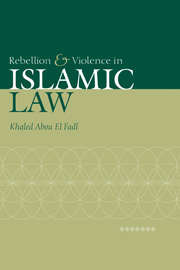Book contents
- Frontmatter
- Contents
- Preface and acknowledgments
- Introduction
- 1 Modern scholarship and reorienting the approach to rebellion
- 2 The doctrinal foundations of the laws of rebellion
- 3 The historical context and the creative response
- 4 The rise of the juristic discourse on rebellion: fragmentation
- 5 The spread of the Islamic law of rebellion from the fourth/tenth to the fifth/eleventh centuries
- 6 Rebellion, insurgency, and brigandage: the developed positions and the emergence of trends
- 7 The developed non-Sunnī positions
- 8 Negotiating rebellion in Islamic law
- Works cited
- Index of names
- Index of subjects
7 - The developed non-Sunnī positions
Published online by Cambridge University Press: 15 December 2009
- Frontmatter
- Contents
- Preface and acknowledgments
- Introduction
- 1 Modern scholarship and reorienting the approach to rebellion
- 2 The doctrinal foundations of the laws of rebellion
- 3 The historical context and the creative response
- 4 The rise of the juristic discourse on rebellion: fragmentation
- 5 The spread of the Islamic law of rebellion from the fourth/tenth to the fifth/eleventh centuries
- 6 Rebellion, insurgency, and brigandage: the developed positions and the emergence of trends
- 7 The developed non-Sunnī positions
- 8 Negotiating rebellion in Islamic law
- Works cited
- Index of names
- Index of subjects
Summary
The main focus of this chapter will be on the Imāmī Shīcī discourses on rebellion. However, for the sake of comprehensiveness, we will also comment on the Zaydī and Ibāḍī positions. Our purpose is to provide an overview of the treatment of the subject in these schools of thought, and draw comparisons to the Sunnī tradition. The Ibāḍīs were the more moderate descendants of the Khawārij, although the history of the sect can be traced back to the first century of Islam. The Zaydiyya is a Shīcī sect which is distinguished from the Jacfarīs (later, the Imāmī Shīcīs), partly by its recognition of Zayd b. cAlī who led a rebellion against the Umayyads in 122/740. Both Zaydīs and Ibāḍīs had been involved in a series of rebellions throughout Islamic history, but they also succeeded in establishing independent states. Particularly in the case of the Ibāḍīs, but certainly for the Zaydīs as well, issues such as who is a rebel, when is rebellion permitted, and how should opponents be treated are integral to the theology of the sect. Therefore it would be very useful to study the theology of the sects in conjunction with the doctrines of rebellion from the point of view of a historical progression. However, this would be outside the scope of this study. We are interested in examining the extent to which Sunnī symbolism and juristic categorizations are similar to or different from the discourses of these sects.
- Type
- Chapter
- Information
- Rebellion and Violence in Islamic Law , pp. 295 - 320Publisher: Cambridge University PressPrint publication year: 2001



